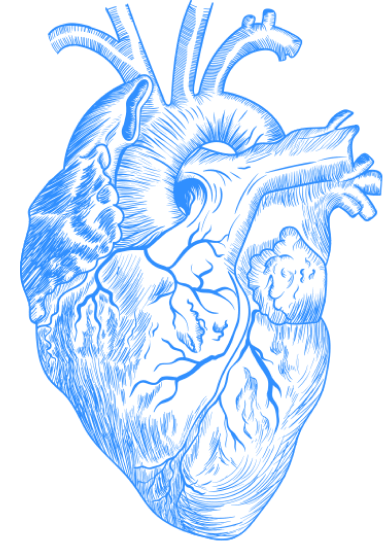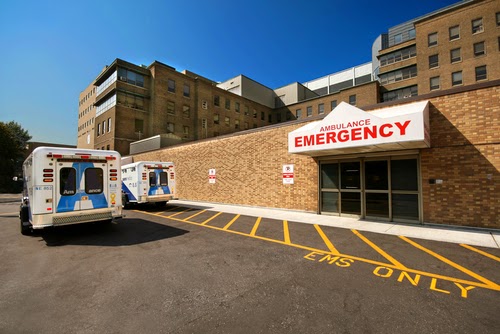
 |
| Ambulance image via Shutterstock |
The Emergency Department is one of the most active and exciting parts of the hospital because it is the hospital’s sieve. The ED physician determines whether an injury or complaint is life-threatening or not and then treats or admits the patient to the hospital if necessary. Someone usually comes in by ambulance or private vehicle with a general complaint — referred to as the chief complaint — such as “stomach pain,” “chest pain,” “leg pain,” or “shortness of breath.”
But occasionally, the first assessment of this chief complaint begins outside of the emergency room. Paramedics or emergency medical technicians who bring the patient in by ambulance identify someone clearly in need of medical attention. Outside of the hospital they take the patient’s blood pressure, heart rate, breathing rate, and temperature (collectively known as vital signs). These measurements indicate the seriousness of the situation. For example, if a patient looks pale and sweaty, and his blood pressure is 80/40 (extremely low), this indicates the need for emergency treatment. However, if a patient calls for an ambulance but has normal vital signs and looks healthy, then he can wait a bit longer for medical care, and the ambulance does not rush to the hospital.
When the patient arrives in the emergency room, he will see a similar setup at many different institutions (I can testify to this because of my days spent as an emergency medical technician in New York City, where I saw the emergency rooms of many hospitals). The doctors and nurses sit at an open station with computers in the center of the circular or semi-circular room. The patient beds stand on the outer edges of the circle in small slots separated from each other by curtains and, in some cases, by an actual wall. Usually, a patient is hooked up to a machine that continually takes vital signs and projects them onto a screen facing the doctors and nurses.
Once the nurses bring a new patient back to a bed, the resident physician assigned to that bed asks one of the medical students to go see the patient. We have ten minutes to interview the patient about the chief complaint and do a focused physical exam, which means we only ask about and examine bodily systems that relate to the chief complaint. If a patient has chest pain, we do not ask about or examine the foot.
Difficulties abound with this assignment. First, some patients come to the ED and want to have all their problems taken care of, which is impossible to do in a short period of time. Additionally, the ED is only meant to handle emergencies. Someone who has a broken leg, for example, may also want to talk about a muscle sprain in his shoulder — but a sprain is far less concerning and does not need immediate attention. Second, some patients want to have a long conversation with a medical student or physician. They may feel lonely at home, or have a difficult social situation, or just want to chat. And while we must listen to the patient, these conversations may be irrelevant to the chief complaint. Moreover, other patients with life-threatening problems arrive regularly and need an ED doctor more urgently. Finally, some patients come seeking pain medications because of an addiction, or some may malinger (faking an illness for some type of secondary gain, like getting out of school or criminal prosecution).
Dealing with these kinds of patients is integral to the art of medicine in the ED. The methods we were taught in first and second year about how to manage disease and what questions to ask tend to dissolve when dealing with human beings who have different motivations for coming in to the ED. We need to understand those motivations and, occasionally, quickly work around them in order to address a patient’s life-threatening illness.
After we see and examine the patient, we tell the resident what we think the diagnosis is and what lab tests or imaging we want to get. The resident then sees the patient briefly and tells the attending physician his or her plan for the patient. The attending finalizes the plan for the patient and the resident executes it. All this might be clearer with an example from my own experience.
During one of my shifts, a patient presented to the ED with severe back pain. He could not sit still, and cried out every few seconds. He squirmed on the stretcher, moving his legs up and down, tearing sheets off the bed and clenching his hands to his chest while grimacing. Watching someone in pain is extremely difficult and can even cause the observer to feel pain. And there is no question that I felt incredibly sympathetic for this man — so much so that I didn’t want to disturb him by asking him questions and examining him.
This is another difficulty in the field of medicine. We need to perform certain exam maneuvers or tests even though they cause the patient pain and frustration. But it can be so difficult to bring oneself, especially in the student role, to swallow that difficulty and foist the necessary exam onto the patient. How could I bear to push on and examine this man’s back when I knew this would cause immense discomfort? With difficulty, I continued the interview and briefly palpated the spot on his back that hurt.
Once I finished the interview, I thought about a differential diagnosis. A differential diagnosis is a list of possible diagnoses for the patient given the signs and symptoms the patient is presenting with, usually listed from the most likely to least likely. This gentleman with left lower back pain, for instance, had a differential diagnosis list as follows:
1. Kidney stones 2. Herniated disc 3. Pulled muscle 4. Kidney infection (pyelonephritis) 5. Spinal abscess 6. Appendicitis
This list may not be complete, but it gives a sense of the kind of approach a physician takes to a medical issue. And as the physician questions the patient, the list changes. A doctor might ask if this particular patient had his appendix removed. If the answer is yes, then appendicitis comes off the list. A practitioner uses interview questions and physical exam maneuvers to narrow the list down to one or two very likely diagnoses.
As for labs or imaging tests, these are only done to rule out or in diagnoses after narrowing down the list of possibilities with an interview and physical exam. This man most likely had a kidney stone, as his presentation of severe back pain with an inability to sit still is a classic demonstration of this pathology. Therefore, a urinalysis (examination of the urine) or CT scan (an imaging study to look for the stone) was integral to the diagnosis.
After deciding on this, I presented the patient to the resident. Across the field of medicine, medical students, residents, and attending physicians present patients to each other in a standard format with an ordered listing of information. This information includes the age of the patient, history of the chief complaint, relevant past medical history, physical exam findings, and a plan for the patient’s care. This gives all medical professionals a concise, relevant, and standardized summary of the situation. In this case, for example, I might present the patient to the resident by saying this:
“Mr. B is a 44 year old caucasian male with a relevant past medical history of previous kidney stones, here today with a chief complaint of severe back pain. The pain began five hours ago while showering with no apparent preceding incident. The pain is only better when the patient brings his knees up to his stomach but otherwise remains severe. The pain is sharp and unilateral on the left side and does not radiate anywhere. The patient took ibuprofen earlier, but that has not helped. He reports no blood in the urine, no difficulty urinating and no change in bowel movements. On physical exam, the patient is extremely tender to palpation on his left flank but the exam is otherwise normal. My differential diagnosis includes kidney stones, pyelonephritis, herniated disc, pulled muscle, spinal abscess, and appendicitis. I’d like to get a urinalysis and CT scan of the kidneys, ureters, and bladder, and give the patient morphine for pain.”
That’s not a perfect presentation (and at the time mine was far less comprehensive), but it is the kind of formatted presentation that doctors look for when they see a patient who has severe back pain.
If the ED attending physician is unsure of what is going on or how to treat the problem, the resident usually calls a consult. If the patient is bipolar, for example, the ED resident calls a psychiatrist to see the patient in the ED and possibly admit the patient to the psychiatric ward in the hospital. If the patient presents with a stroke, the resident calls a neurologist, who treats and admits the patient to the stroke service. While emergency medicine physicians are excellent at figuring out what might be going on and whether it is serious, and while they are meant to know a little bit about everything, they don’t know as much about specific problems as a specialist in that field. Therefore, it is not the ED physician’s job to treat everything neurological, psychiatric, or cardiac in nature. It is the ED physician’s job to determine who needs to see which specialist physician, and to treat those urgent problems that they can treat.

